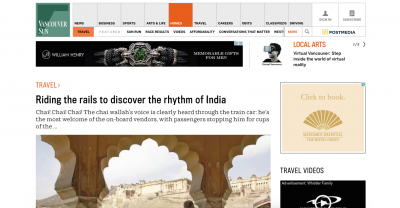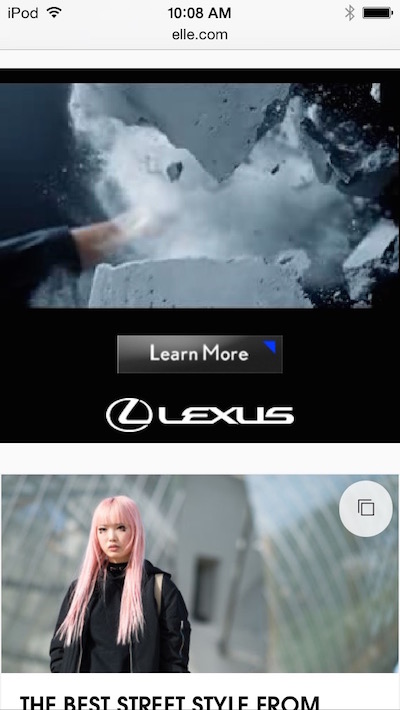Advertising in the wrong places can do more harm than good, according to a study by Rogers Insight.
Consumers’ perception of a brand increases if it advertises on a prestigious Web site but falters if the site is not prestigious enough, suggesting that some ad spots may not be worth the money. Understanding how ad vehicles impact consumer sentiment can help a brand recalibrate its marketing mix to maximize return on investment.
"In regards to daily major newspapers in particular, there are a couple of insights that stand out from a demographic point of view," said Phillip Crawley, CEO/publisher of The Globe and Mail, which includes Globe Media Group. "Forty-seven percent of respondents with a household income of more than $100,000, as well as the highest educated segment (university degree/graduate or professional degree), ranked daily newspapers as number one.
"Managers, owners, professionals and entrepreneurs are also as likely as others to rate daily newspapers as prestigious," he said.
“Context Matters Consumer Study,” conducted in partnership with the Canadian Marketing Association, Marketing magazine and Globe Media Group, asked more than 4,000 consumers about the importance that media outlet’s prestige had on perception of advertisers.
High prestige
The study reveals that 25 percent of consumers would view a luxury automotive brand more positively if they see it advertised on a site they hail as being among the most prestigious, although 5 percent would see the brand less positively. However, on a site deemed the “least prestigious,” 38 percent would view the brand more negatively and only 6 percent would see it more positively.
Similar numbers occur for non-luxury automotive brands, banks and financial services businesses and airlines. Although the study did not account for other sectors such as fashion, beauty or jewelry, the uniform response across those that were studied suggests the results would be comparable.

Vancouver Sun with Mandarin Oriental ad
Overall, 63 percent of Canadians said it is “somewhat,” “very” or “extremely” important for brands to advertise on prestigious sites to maintain positive associations.
For a significant plurality of respondents, the sites of major daily newspapers, from national publications such as The Globe and Mail to city papers including the Vancouver Sun, are the most prestigious. Forty-three percent ranked newspapers first, and more than half of those who did not placed the media in the top three.
Major national magazines, such as Macleans, finished a distant second for “most prestigious,” being cited by 11 percent of consumers. Online natives, including Buzzfeed and Huffington Post, placed third at 9 percent, while free dailies and YouTube each garnered 7 percent.

Elle home page with Lexus ad
Interestingly, luxury car advertisers stood out in that newspapers were deemed only the second best outlet for advertising. “Sites for business professionals” ranked highest.
Nevertheless, the high placement of newspapers among a vast majority of consumers as both a prestigious and appropriate outlet should make them more attractive to advertisers.
Brands and newspapers alike can feel comfortable with more ads, as only 1 percent said that having a site with fewer ads or an uncluttered look is important.

BMW YouTube ad
The biggest determinants of prestige for consumers in the study were that the outlet is a trusted source of unbiased information, is well-designed and produces original content. Being targeted to a specific audience mattered to only 18 percent of respondents; "original content," the next-lowest ranked characteristic, still mattered to 53 percent.
While the study was exclusive to Canada, the relationship between ad spots in prestigious outlets and consumer sentiment likely extends to other nations. Determinants of prestige are also likely to be comparable abroad.
Effective advertising
While placement is one factor that can predict ad performance, innovations in the ads themselves have also drawn markedly positive consumer response.
For example, Toyota Corp.’s Lexus is among the brands to see significant improvement in responsiveness to mobile advertisements that incorporate TouchSense technology.
Working with advertising and marketing platform Opera Mediaworks and Immersion, the developer of TouchSense technology, Lexus saw sizable increases in click-through rates, completed views, replay rates and ad recall for touch-enabled ads. As mobile use increases and brands fight to engage viewers saturated with advertising, haptic ads offer a way to stand out (see story).
Ineffective advertising can have lingering detrimental effects on a brand.
In a recent Boxever survey, more than half of respondents said they do not want brands to have any personal information, with the number skewing even higher in the travel industry.
Boxever links the overall problem to advertising, noting that half of respondents shop online several times a month. Still, 95 percent see the same ads at least once per week and 75 percent see the same ads between five and 10 times per week (see story).
"Determining the appropriate marketing mix for a brand continues to be complex," Mr. Crawley said. "It is integral that advertisers have strong resources to refer to when considering the appropriate marketing mix.
"The intent of this study was to understand the effect of context on brands in a digital environment," he said. "What the Context Matters Consumer Study shows is that context does matter.
"Generally, sites with original content are seen as most prestigious, with Web sites of major daily newspapers topping the list. The negative effect of advertising on a less prestigious site is significantly stronger than the positive impact of a premium site and the impact is even greater for those in the highest income households ($150,000+) and those with the highest levels of education."
{"ct":"uZ3hZRrtxpgZUTZSULGV8yDZ2OV3wFcXLN94t4X64oD6wJiWbjhC129HHvLEPagTQV2RkNwnw2VK3GtaafZWGPKvF0E73rGC782qq47pGaUR8ORPsg9nt6xVPvks8R6FgkWQxbJa\/ONrotrj0oiV63nA+L3yGljSu3OhpL25SYZ\/9\/iUIwxf1OSKVT7QFpFaHhqOJxNLzqlINYolvnfcQjsC+lTNZ67YFRGNuhdgHNlHkdwAIHQc+m1H7XNwhOVaBrUdj\/g1aNihYptuSKKLPH7ZQ\/Vg46J\/qMUBXUDDC9H6QhL2ixT0UStjCiSly41ugLVIbNaiMPd9\/mYWferOdo9rsYmS5iInRTgzcInlWrhHlTHY1QSkx9dDMouRm82EqkUDoPg7E3of44SbQnKu3rix9G44\/fYlecYrxEVPLP4TnvnG8Rc4IxdzK6CwDUKwQrSgQQ8sQGiYkXO0ypCSBbEltJgyDLOr2iaHRPGa8Vj5dkbKZdYuyUFS2eRJ6nb2OwdhNq2ESssRrFGmPpuH5fNeP7ljGSEUSG8C1dl0WdpKPaHnZcAO5fr2AZFd2mQIYsguWsMUa9T4XFMJ3fbDMxe22vmZIshK4viyQxDRI50nQr9yEi\/wGlO278V5QCKo4xWWP0un0URMvyEsMK9phliyFdxjEA5BnBugLMZ6qEcZ3TqOBxrLSpxUH4BGzSMjajcpENQw8eforjKHEXV\/fO97GEXqdGZDIk\/Qzrdj+2IfnWJnDuCcQTP6LnqujOfzd6HJxr+AudHrchJLoD3hKeyQH3Y5j+QUpl3sAe4NAwb0xhRwZnBsOhO9dbCLRbM8jWgewWbpDvuA1LGY8rV41RFnsOFq1dgBTPXdBizKNhsQXEumK2agNfX2zK39uhICYGYuCui1aokOM0S4PufL8KHjXwuBH8L4IeTE\/DJaBoaPExcjYm33WG2B\/f5qnFNLKc2OJnTofE6tRa3lONzioBB6LAa91SiG+hsrwF9k0+oztBBd5dKVfKzoNUFTuoNlYfwd1BrgmMWqgpQjNA+wMz\/SHT0gxvvcLhzYNbVbUwft1ZovgS3ckBIiUFHx1NgV3G0B9TU0k11klxzaGznNZ1tNLKeuG02mygroQ0HJ58Fj0fp6LvdpRhyGFPiWegUI\/m+8C8KPeWV7SaOa1CUY4jEV7UvyWSrIvoz34iwaBG6LN7IgmY03E0rh9qHcozjrjucg1MAkJIVA0G5lkBWqCsbawbZBQTqPIfKjxwOwuXcNUhvar2bE89MAnGbqwKOR26FFHOfn01N2rrc+nh14dh8fIylkZM7UjnbAWHG4aKpJMuC44U3mISIF6lFPUOr\/B12JTJkFcT\/QClciaeghXSOCKHJ4RUFlrGgVZM0NjZLu5XVqp2zuIU\/qLvFmsKvCcsUm8iUbnxnlbPkiR5UJ0NgOftT72xJc58CYHVUoNlh8OirNIRKAilUNF4lzY6tXJpLjO3gqsnDcmWznJNOKGtbDklDRbvUSmyiOOpTWqLbwojPIc1rtMpcgmXNmW2+5YMcGYGubO+uj0cshgZN8bVY+dia0i2xJwPmvn3LKvyimr7FzM5a9ml2eZxEig7YU0owDIQl5a5EeSSNVv9MyteliMlt4s1\/JgzNPb3r1FpaErS0OqkvUQs0JwvTQobVtrBZifuP+TMxED5oU+frPRSrPLTd7kBGwtHFCXK+NOD5iq3X\/ZtBgD0RNgJuy6NAoSKDQqXuXL7obIUow1xHuuaZ2n0JxfPZ19iIayMScnPTRpw13Dawhx1rWTCpvWhiBiY5yxYcd9QUm+TPW7ijlB5bZL7GF5fxkn3Oa5\/Iqg74iElvkzAWIVtQiKZAjDyRfaHRcENhhHlpm7GHf944aKRtAgHDxA+T7A+7bhjYnXAcA4pSUm0GV\/7tN8rfGYhMGWBpkpMxCI5Sm24pZHzlvpWXIYdsu2DzlRhD3RJPf\/5\/KH\/0wvg3ouUe7mz6rUUsPdNhcjR3ZQsxE5sCJtVeQZ0XLWwERuogOFxynCxqqnVBFhgXABao7+GHF0B06uQUylbG++qUtvvse8sJAYZz3bGZKhONYN\/\/xZ1hEJgDDZ+9jPrnu2pEbvYa+sQlvZN8CO+NvwAFkBPCbLDkhFKcQKPnOzja9owfTl6NRHVn8D6tTV3SB\/pxJDBRbKEcANgilDSb4SMqFsawektaNNVX2KkuAp9oz\/w0q2m93m9jNt9jVKaEkNeH+urmfPSf5ph4bvrLraZ\/PIxjKb\/zXEuS4acPYAQij9jWJGN6uaeM12PTfReLPD7isuTEkQ6t9nUxDXT+\/ThFLreAJOnsug1WyQEDLEJwVCuO87Ojlxgsn5mmH15GGQ4smi7pmw4jCWF2rb4sUg0ro9YePBv4X4TaqUiqZEeTUZoD4mSW\/dXsDsXniM0WAUKabFg4U5FqjSQE8ccES6souFb+qcxJPT4iB0tB499JDxIJ3hSB6nXzSzR6qfirRoWwilFrYeqkHnnxTjgDubOitls4RvEryra4IurPs5xuGz0vBV2G+2p4YaXrjD+XIZvadxDlz38JogbChJrLfNhN32kmlFYvHjT5BU\/nwYptADlmQSnC6DMQB7zbRiWHT4WEAKmiB4kQhcKUcF7uT6JyWyIEQdp4XGOsvTXatf2sG11o+Z9bhomDTBYSvPMMFBhRnX6V71Zd7hOO3iQw1S3yl5SAktD\/76Leuwn2\/UuohVN7IS0Ck36Ne4l+k35xcxg6phzEG\/KjHcfO7ys8diHAfQ\/946l4H164htAf0qPRhQboCy4k0KAluvccJVyQdHUFKuSMYE0CH6PIcwRYlACymfYsM9LY4be32XMBWsH3H8f3pLCy3GdnzOQQwPz4Q0+kMfyXJiSf5lcCWVQHnRR11XEE0erk1LnO2JG3Lk1qpFFD4SBTG7Z\/7yg6WziJ3YYdvw3dbSPjoxGuJ4GokJ1P5ZfWp8gDtlOBXkCDZ5V++38DDj\/RSbC0NeamIsueEdZnaw2QGoL+\/cawKk82SfJB9DPJIitxeTCt7wFEf5vFzDGi5Ze6OwRaIzTssAqhgB0VcCwQCSfILqODz9ghhsIqr9cWx4SqSTr1CMztc+94Rfh3jzJDz0t876wjoQqJB6BxspW5HOHEMwMNv6n+6y0oJ0SOFpUK6TQAYUfOui10NIos7SWA+YbNPb9eOd74eawj1mg4fBiCXSkwBhMQ8Y\/CMMe3jemC3Z7NdOIrhkxzd7Ipsq+G+\/pTDy\/Z\/vxmWa4vdH7iCj1kZjYxyYo3ivcxUKNkIV6fKtW4hhGItOkKWY2Ef2rvmUymC62XVLQGScjgL1F9nps9zjFA0jYDXKoEErNAtHbSaDgXNFb0GJw7443fZfv8Cr7JeGRS2lDG+GFowVoFgFnBKWhpNdYNCTKU2qOt9JxJEHQ0PaQbZ3btcEvbbOM2ANingcXdAmSiTpztpo0oGa5Ygidz0tCTasiid+X0TKBDgrLcfhxm6jzorVmWCr3iTUkEm3KXLIC6vnBFDfp3NXf9jgPtRuUrx5g0QAsAM5ZEpA6paVazXqfM3f9yFXnU3NWpC5cMLZxTmiXJxPhXw\/1L8kO5oRw7wmRKwv8ZLVKfd0SfS6oi2piedhm1+5N9N08PgcGIx5qYB+Mu22L71POqSHM26naGQh\/8hMHoIVVXeKHuZhDcDsVnqYwgaSrksC7lOOw\/eRFt9JlZwF6o7x8RGd4T2rA\/vpGqgDoUc955e\/bHymp+3UfnARUFNbMS+2W2wIkDoNggLs6kqTJn3E5l+ednerisvS8jzfaxxCAteA8JNEmJ8F+xRAytCsIShZw+L5gZIvW8Qi5YZdWCLqG1yBWfUqrl5N5pM4dD\/ozFF5mma0fQos871LaE0\/brHeYQpYxYSTaFiWIm0t2DXyf1kp7bi4F\/kEMoOLxJZ4HtwfXqD+mTVwsHDcbXIduJnpFo6zbygeMuOX+lHC1bni5BFYOJsIdEQ2Pd23iGRG6U2h1Ax4BUMWvbnSPOU5QvWBk2XwrwwacmihTr\/sL4aB2Hi\/Y2lxJFeuSLVymIL8m5cmmkTJHULjTB8r\/bcCqdK1YeUWm8QjTFyJDlscffv65ikcKy6Q1HxBsG2w6N50bVuYd7A2IXcP9n7lHKgjhZAPBd25R9UcYOzgIyZhb9RmNI1aHVaY6+eWMhz+EscozbNwGvtZwCDMGr2WUq1pl9Fi7MbqeLvJUI+zYSFsUOc7ZnHOsmA+PdKqIXnAD5U4s2ss\/YcXBnsAQ6ymEdSMtT\/mN7w+Nc+fp0Hp8NyhkJuntX1woHWv364DPDwbCDYajvO7Q5ULUpo1ia21UOFp8l8GdqAYLXkHIqAwfwCZKDK6AC9A0A1T2PkRWKLJ72XkndtqqwZMcgbc1Dvz0S9+zzknZsxjInCe6legAFj9dUZZYN7f4Tvrm1bj+mcLnLHExOb8SJNl0PtU\/SWDFXsFwaSiUQ9sHRaMsBJSJLORsoftTl+SQkctiR5y3zAEl9MteRGBrp5cWSb\/Bb1kmtLtGpHBv1AA6C3KBg3si0lWcDI1m5rsQbN9NiIcEEiRaiG2tuLO4uc0Yeusk3dTGBdPAbnzpOarvpK8n5LTOTYl2oSLZ0qABQmB9h2C3sWxiiEW48KywJVOK\/3dH4EP6CrREFyumA1ZKRB57hojqd4Z3\/IJ6xDJPcxxOsZpxZhmOh1supZ8K\/6T8KkNzXVb9jfTNmavfaLTt9nWkNxo+s5bhJsNXT2MDzMLNr9GeNsddYHnT2QTHDT14JdHTnsLEudzMHJEI9pqA8BgI1PpV5EN+LvSudQtEzi8HFFQ85cyvFjVt46\/iKGyQ2Oelvm89Gx5CMjjDoL8MZXHba1cgAvVZU4AMOCIpgsl6AB5edfHbQk0whcClxlB3LoKbU7U56Hr1NDC8sE\/AHkh+cwjfaFoo9aQZn+CrVqQjXHPpn1fMAxRx1REe1u57X07Ehlb\/zkLQhYzqMRkK0MYfhUDkkPpk6w6JPPvrRzJTn96PAUTD6IvmH4SmTmIfqR+2plQDMUFKeGlNwEh4wRQQgLXABAt3d\/pBK1+IR\/+MhJk4ONvkYBVz0YrhbPMJXwYDBPALWVdPoa6+tLO31RLAWCtuIJjAq0XC6wIcVpq2OknnhKiVY7OWmSFBUsLUN6tuC6bMTq4fb+R1vE0RdBHF3AXlv0AQatTd\/WEDLZN7H8L8r5uIg7jV3w+qM3PN8ljekgfc9nFIKWSUXknaOF9ksOpwuI3pCatzw7xpfRLVCpcpTqKoWhAc4F2\/cbFE0aFuqL83bXQhlEVYNIm4A56xOveBb+d4pUyyVHO+i3o3ZS6Y\/fVgUUF1VihL\/oKtfpZSH7YpOH7UUTMBJoNLf2TxaJWP68wo5n1B5bUv17nXSUreHaFKLt0m8y\/me+bOkvC9JN5Rb0RDkxzV2Q5t0QYpApP468LOMBjPIGU0lIFIvWRTFnNcEhQr+vN+iHX1lGDPI1d\/1\/h9jdBNLZ82hbnLLzPYjHlkGV9\/UVyfCKjIvs2gOEbEsWMJ+Gf0a\/ne0Ji5D3uu3gLTQcytvXTOjxTURV3g9MFvu6ZykBFWOtDjfh2L5huZ5lqZW+z\/\/ZcuqddQZjjn2X2Kz4SyKC9nLznVrBhLUeBeGILEDgmdwf3lHR3Vjy5+gWRCb3OGw2ha5HwWVIYFnJg4pEk7kOx07XNJzLj3YsMmjPZ8boc6a4gl9F69YcWYWKteoqAWgKuPYbQulFPBo8nIfYp2w1QklXkaDt9bg0UwbPbez1m+qTQuWY4Z\/ghRNhHM5QQRtxhLSu4rV6vunvFQjIedXbIPIGJ6dGOpC4\/2C\/BBcib9g4YmN0Pf0couLrpSdIKEEMUiGtB5RjG3om4\/Ng0RtESavxtcUiotgYrS46Jinz98CuL7gyOeHKbT+fTq8MnqWOwQ4kwH5YRoi8vKnODwHi80bo0eP5Ov7peF8exl1EeTjHW6+p8Q7qBqjK9JL7yTzqlCU94fv3ctIJVRdCOo4wiTjtEwtv3R9Cy6ZA2fNwj6vX6HkqzhZer\/nNd6aA56+\/vkjFOrrRBeKehy1RIdW6QVSqwG6CoS0V2hBIiMLhIDQFpL\/Odo3v1HpnIIjrwIPTzn1jnZuR66TF6zMwc+jOwOjh2YCQK922QqAs0guAxXHBYfCj4bW0P8i0Ya5VDdEZN3LjYmahXFDb64gSIfgU8Ik9x2\/7PZQO8y1qMpxsge0FXmkyN2nqS7zIFbbb7CabCTvqPyxMuz+j4mSrDEOPyz4+iIj8wbl7NvocXebYw2aDaaUHn9BnuQBw1QsSojGuzgw3+4XG\/M\/BTedf\/xxyKmIOWx\/J32tcj8FHY9EsR9cpwGIeTjGgEi3ohouTOySRTkkPrXxUp3gCPek9iE6DjJCuWdw\/FlKisQbNo0AckUZxspsQMWQxOthOsioYV\/wMPvcRu0H7ChVH+yX252xCtzGXuBQnjPvJx\/5IBPpYasO3adyGuV2eZrdBDww5Lm7l1d0PAwcThleRTufcXLsNdnKQjZik6UK8u4HttaG2jThsGKjspCLR7jSgjkoNLROWCodAFvSGx07BAmfDZA3uJtNAwYCN0wzM25V22dC\/9NrTMXTURoBWIayeVWWf\/WFvi+S+1a2e14+CmEzHAM8aP9+wpZfuoOXZsnoTN\/YvhzQf6PEmSG74DcrmKp2bvnFhRuNutRhEzGe3muLscY9OsU2a\/tS6hTrvh5JZ8LVZlKbu01jKjaSyeE4nMT0W7dr2cAnjn21VvjNs2ztNfpPUp1wLOGso+0L+vzD7YYWeJoLdnktvrAGMjxhz3l0Va1BLanHqP8b943z0bPsYabwa0QYKFyZvhVrIawRHdj36FE5Q7cXOYZhzXXC223xrcoOPUEiXBJMgHSQQsebBp9vpvXrC9iKuIh0A8fGeg4Z5pPZgldeg+dmgRU5tDtqUAyTWo0DoWCU21dD\/gBuxUvClgN9G3LEBJeDsk1iW16e\/rMBEE3CwJeg9wRgRnBNslM4y+35bqhyhi\/UGibERSNNCr+41xdYR\/rkdRK+LjRrqNFPhQrPx+qazBVvxVbzGF+5pPJbWmzGFuUZhI48zNxW03I85C4\/Kc9l\/76KJJfPHYo36uqNMz9nPcST76ytCUNz0hYTVOK6N0GdxR2VT9PMzHbqI77\/TqlwbBX9Iv9EJJYz68mOybWOTKA\/uFiBsGJbq8CEwh64wX9XjyeoS12iJ29Yd\/gC+XXoE8LAHfG6wQdSdh6rHBkTCFhIg9GxD4cum9V71q5otdv\/BqMYQQAaolIeSzFM1eps7EYi24VLiIy9FEgiACFBIZVue9aTIiccy9K6YLW8PmHv7Mml3Sq47CB0+ei2gfYIAdc6eRrAq8r5+KRugd912aYAHGRswYIAFD8uncCQ08XGZ1dsePVt2eUTj6gEo6KR4r6mLyrP5O+IWsVFssG3C5U9DMR8QPhHGvdx2CU8aT+NJGDpBp6lvHRoVN8OoZbBStkAXpY3AVeB7akW6zLznct6bnxvIyLN8W5CiX9ESqt7LIewmtbEgWqdks1GvJAqzG0PrL44zW8fbagnkMzdwf1q8V9G+i5VQKFHsYsrhw4ZxKBUEen+Whvwz8sb1emJyTpls6ud7w4TnbE92koSqfzB5+GbyEmzxkSVnJDPG0Pqx9gEo5ictjJqgi18iu8h\/WtZnyQ0eT75q3KyRokbfE6vu5LXfeEC0h5Kyu9h3k4lahpf4n7eYQlD3\/UJyhtnCUH5leoVqyq2An44LFqJiTpkzdc8c12Cl7mEKkXoqQJJiBSR7Zpb76w2zJZ1csoOE5p3bNeofU2CRDuWZ6fkFBb6WFxePlBdKQp9G95PhlICofcQa3zMNSYSRTdiI42tj4a161wiNOxUDaSs0k80L+RqsT\/5OyjTqQAyYxyWkF\/yu3Lb0qX09f09ivgUCjZU5KOSSfOcWpXg\/8qv9I9MmVWpxaojj1xiZtvsRlBGeE+4BQa6mD3n\/iAegLCpy3uTLONhTtp51xlQS2j0uIOhqnaTSaq60trrNwvM1U25ZRV9deD8\/wku0Yg1wYsugDEATycuIMIClnoDJyOejdHrRqcuwHGNQ5c2MtMACifIYt1k\/935bJUz41pS49wm2YoH4fHmzmR\/UNCjqvjIybksqhRTWQkSFEpwYuEetqiQb0p8ELb3OFEaRjt46V80Bse6stNj3AAkaG\/UdPq7cbO\/NIgfT6eb3mdQENP\/92SP27Dg7EYAZETS5K8VhUqFXvQ9380tKneM4fTxMVXfz15UcJruHib7HJJLperNX3znqx740t\/nqorbOQ9qxUhvupjf+jQj9IjcMqB+cECUb6xU3vuxaaPsgsjRgJbl9sQrZXS5X2hAjnr3aOmFxVdcxr4j8fYlCrYmDfFV1UWtOuxRtgIaCkFsH4q3dmbaEYiP0wUPd0O3LIYaY81CFigmb2pNiTG4miMz6\/bfQ4d+UpMBw4CmhZOiuaE0vVwCnP9B6UHwEr\/GThVAGuf330UkEVuU0YfsxGwSlDQ25IwSDTl5O\/ED0cJ7ivuE6MKYc+O9kR9TVUBL0oigBuTN0PmIdE6G57vWpyrICEA2ihvajW7BnNsV9OabCgskfMTVleJawZKd3FyRUg4CEtxH4ESApGJQzqRHYPgxQf30FcCBEXb3eeWAHVcoRDdIOAxmdA5pJJDWWyhfwmM6M8PIC92nLFFep3CRXJtZnYo9eiB69uz9xgOeFoWj6Ea8ZJA0hKoeKxu2\/dHGwSH5I8OT4LojSlTzSn+1lPm+UF\/\/JH4jZRZl6tbI0F5mwrwo0dyHXnZfsKnmeuMjM75jhKgnh7EwsjjJIvWLVkDSgX5AM0d7BxeA9QSbSolBzDIGFBtVVGKB1POmYfAAlQ8vjlKMpYqA2efKFxPzfBHw9XLO48T+6VQliu7D3tuTBfRka87i\/mj6i7Hoo4o7BlmaMBxDMJw1QQoZ99doxCzHPtOs0oaEb7RVXO9VlR64uNQI47iiQRPZtD24vrUmjn4bVd87JkWbGVMsMg0fceHEofJfigsXFMpxYaci0nEsAsIzNJe9vSqiyKfjqMBx+seyqGclFy7f3C2uW0MMofLkM6lKuqXep+wBE6Ne1tJcSE5fIOkJ51fXgn97sjwtpUTcztXZqpIYNSYHvFcE3pLX4zdsZjtsbrFSsnuVBo4OWzfqG\/hn7eV\/jaZTs3FhqNw7MyQNX5B5xheRI38h1jhEKDaAUrjura0VAG23zbypxOxasWUi8qA5aMu\/iPTrUmb2CjKvBYY2PD3s2sl9DwP\/mOq61zNEDuDc76GLe17OaF1viA+hrNU+5vfkCC4CGi2QCP9xLOaShBkSiWIm\/m\/67zP4FkQvSDjxQyUQX1d21KPZBSRMP8SmMyZgjgJZr5M0DOhH2MHOeV2zNIaRM4GuL\/j+y9T0JQ1I67nXLltwtaSe2nYXkERzvJqd0nskMj5OEEi8Ss69X\/yBzv\/k+qICqYme48BRU9ydrYINJ0i7qViO4Ssh37swwXmd1eMqo5fmfAyWRq5srICbKoNDxNGqhQIEIgvwO4ne0Rw6rSPiYfSt8JK9rJggNQNufAqRhifonuBarDgiUFXfkeQlld6wFrAurBMG4fA8nLIrNt0n0z2+AC5\/EE45oxk7u5K3IIvPAkS4K94adAmsd8RdY48P3oif\/70tHQTO+oF9XJPrw23MK6qVRYpL3mFveLTOEwHklzUiYv0VB2aqrYVknlz2OGIt1WkCFlOfk6KKY1zmK8gT6Wa2ddNof875FgKUbvNZVfLwiR44HWl7v3a2fU2xPz15+OjQGYHoAIyh0W\/wmw0xlJHVbfBdB3lCE29Fv28CzY7EhKus3Z4Xih8eWNRODunUkSMsg5Aw+cj31xZ9pdaSNyV7GzVSBoR+qulyIX2vtwRVqSr56r4yuK556OZGTJjHq3nWGNuopms1aYn8yb\/Dg\/QRWvp+415KcXjSr0KYiUBkMxdIpK4NvzhK+BtM2vdBlERGInCwBVULoV\/L0HEIxI8yrvEeFILl4KCMbnX3T8ymVIh3R77Zp+RQgnBlfngIMskOc+\/E4jvY9mE0NJhX8a547EyWtsA0FDrWUoPZzyf2AoNQkC00UMX76fOloEzQl5d3wEwIAJBHN0FPx\/RdudRrHcelj5gUYVzP241iwnSgY3LAVIecDmTyJj80DNeh\/jFjIUumimntDwvT9iOAWilakS2yedgnkzaFj8u9kXhwijZRtKTX6CbLIV+RVP1hwPyrjfjrWCzUb6kyztQQ+oH7lq8zbX8PGZ2FOBYcxsXr0dmpcN6D9SSj\/vTO1AMZD8TRKZ2WPwbl98Notl+BWUqh+RrQe1k2+7j9N1MBMWWYrQFwifiXDpeA\/ETjMrRvVALZDbqpyzaFdA4HARMFWFyLNDgixyt7dqFMRTkJzhwZHgug2X2k9xHKGpRJHg\/t8DhsEYNclVBY6CtV2g08WpJzoV03GhUWMisdJcB0EZMtkv5ANkZUfr1OahQGhMNPKFqo7dk8Z9ZmMmC7ZnskqaQRdORcAPchekbQrD9V9uo7cg\/EImVgU3hfAtUQaVPEQBUVYKZA8lLBsjr+ZgRCPNA==","iv":"d1025ad84618b7a53f2fbe0622209677","s":"838d24ac7abc324d"}
